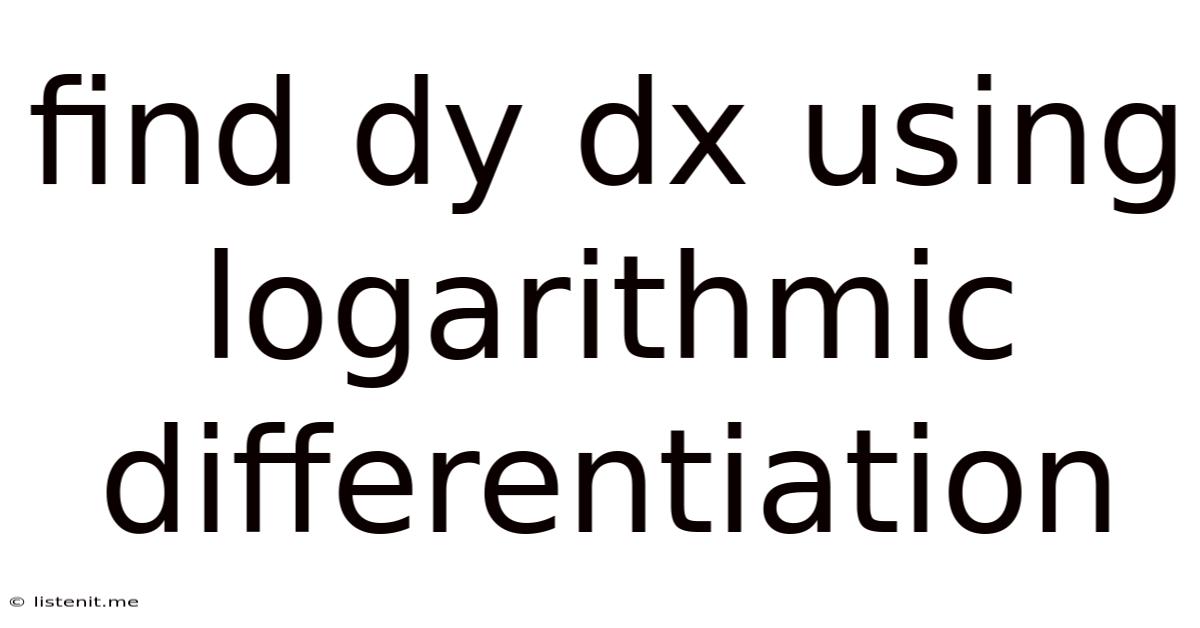Find Dy Dx Using Logarithmic Differentiation
listenit
May 09, 2025 · 4 min read

Table of Contents
Find dy/dx Using Logarithmic Differentiation: A Comprehensive Guide
Logarithmic differentiation is a powerful technique in calculus used to find the derivative of complex functions, particularly those involving products, quotients, and powers of functions. It simplifies the process significantly by applying the properties of logarithms to transform a complicated expression into a more manageable form before differentiation. This guide will explore logarithmic differentiation in detail, covering its principles, applications, and advantages.
Understanding the Power of Logarithms
Before diving into logarithmic differentiation, let's refresh our understanding of logarithmic properties. These properties are crucial to the technique's effectiveness:
- Product Rule: logₐ(xy) = logₐ(x) + logₐ(y)
- Quotient Rule: logₐ(x/y) = logₐ(x) - logₐ(y)
- Power Rule: logₐ(xⁿ) = n logₐ(x)
These rules allow us to break down complex functions into simpler terms, making differentiation significantly easier. The base of the logarithm (usually 'e' for natural logarithms, denoted as ln) doesn't affect the final result, although using natural logarithms is generally preferred due to their convenient properties in calculus.
The Steps of Logarithmic Differentiation
Logarithmic differentiation follows a systematic approach:
-
Take the natural logarithm of both sides: If you have a function y = f(x), begin by taking the natural logarithm of both sides: ln(y) = ln(f(x)).
-
Apply logarithmic properties: Use the properties of logarithms (mentioned above) to simplify the expression on the right-hand side. This step often involves expanding complex expressions into sums and differences of simpler logarithmic terms.
-
Differentiate implicitly with respect to x: Differentiate both sides of the equation with respect to x. Remember to use the chain rule when differentiating terms involving y. For instance, the derivative of ln(y) with respect to x is (1/y) * (dy/dx).
-
Solve for dy/dx: Manipulate the equation algebraically to isolate dy/dx. This involves some basic algebra and often requires substituting the original expression for y back into the equation.
Examples of Logarithmic Differentiation
Let's solidify our understanding with some examples.
Example 1: A Simple Product
Find dy/dx if y = x²(x+1)³
-
Take the natural logarithm: ln(y) = ln(x²(x+1)³)
-
Apply logarithmic properties: ln(y) = 2ln(x) + 3ln(x+1)
-
Differentiate implicitly: (1/y) * (dy/dx) = 2/x + 3/(x+1)
-
Solve for dy/dx: dy/dx = y * (2/x + 3/(x+1)) = x²(x+1)³ * (2/x + 3/(x+1))
This simplifies to: dy/dx = x(x+1)²(2(x+1) + 3x) = x(x+1)²(5x+2)
Example 2: A More Complex Function
Find dy/dx if y = (x² + 1)⁵ / √(x³ - 1)
-
Take the natural logarithm: ln(y) = ln[(x² + 1)⁵ / √(x³ - 1)]
-
Apply logarithmic properties: ln(y) = 5ln(x² + 1) - (1/2)ln(x³ - 1)
-
Differentiate implicitly: (1/y) * (dy/dx) = 5(2x)/(x² + 1) - (1/2)(3x²)/(x³ - 1)
-
Solve for dy/dx: dy/dx = y * [10x/(x² + 1) - (3x²)/(2(x³ - 1))] = [(x² + 1)⁵ / √(x³ - 1)] * [10x/(x² + 1) - (3x²)/(2(x³ - 1))]
Example 3: A Function with Exponential and Trigonometric Components
Find dy/dx if y = e^(sin x) * x^cos x
-
Take the natural logarithm: ln(y) = ln[e^(sin x) * x^cos x]
-
Apply logarithmic properties: ln(y) = sin x + cos x * ln(x)
-
Differentiate implicitly: (1/y) * dy/dx = cos x + (-sin x)ln(x) + (cos x)/x
-
Solve for dy/dx: dy/dx = y * [cos x - sin x ln(x) + cos x / x] = e^(sin x) * x^cos x * [cos x - sin x ln(x) + cos x / x]
Advantages of Logarithmic Differentiation
Logarithmic differentiation provides several advantages over standard differentiation techniques:
-
Simplification of complex functions: It handles products, quotients, and powers of functions elegantly, simplifying expressions before differentiation.
-
Reduced complexity: It avoids cumbersome applications of the product, quotient, and power rules repeatedly.
-
Ease of handling fractional exponents: Logarithmic differentiation easily manages fractional or negative exponents, where the power rule could be trickier to apply.
-
Efficiency in handling complex expressions: It proves significantly more efficient than repeatedly applying the chain rule for nested functions.
When to Use Logarithmic Differentiation
Logarithmic differentiation is particularly useful when dealing with functions that are:
- Products or quotients of several functions: The logarithmic properties directly address these situations.
- Functions raised to powers of other functions: This includes expressions where the exponent is not a constant.
- Functions involving both exponential and algebraic terms: The ability to handle these mixed terms effectively is a key advantage.
Conclusion
Logarithmic differentiation is a valuable tool in a calculus student's arsenal. By leveraging the properties of logarithms, it simplifies the differentiation of complex functions, making the process more manageable and less prone to errors. This method significantly enhances efficiency and clarity, especially when dealing with intricate expressions involving products, quotients, and powers. Mastering this technique is essential for anyone aiming for fluency in calculus and its applications. Remember to practice regularly with diverse examples to fully grasp the technique and its numerous applications. The examples provided here offer a foundation; exploring more complex scenarios will solidify your understanding and build confidence in applying this powerful method.
Latest Posts
Latest Posts
-
Find The Equation Of A Horizontal Line
May 09, 2025
-
What Is The Least Common Multiple Of 16 And 20
May 09, 2025
-
What Is The Smallest Level Of Organization
May 09, 2025
-
Can A Scalene Triangle Be An Isosceles Triangle
May 09, 2025
-
How Many Pints In 2 Pounds
May 09, 2025
Related Post
Thank you for visiting our website which covers about Find Dy Dx Using Logarithmic Differentiation . We hope the information provided has been useful to you. Feel free to contact us if you have any questions or need further assistance. See you next time and don't miss to bookmark.